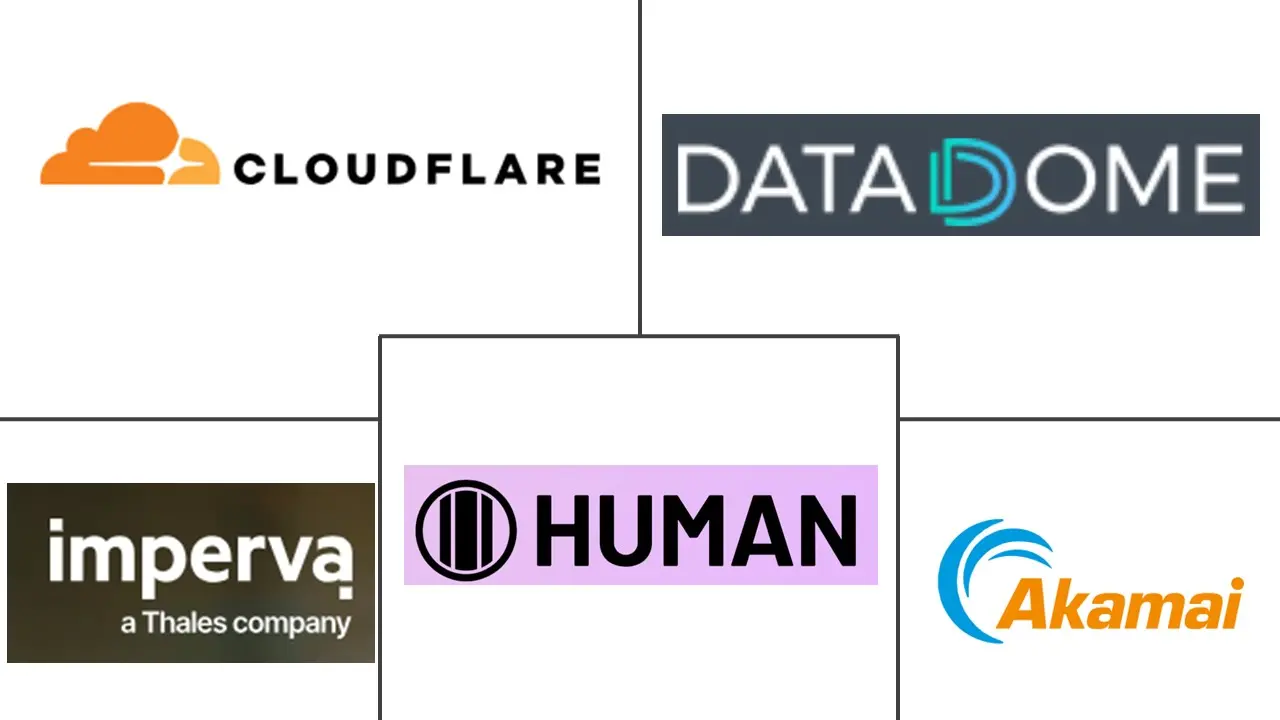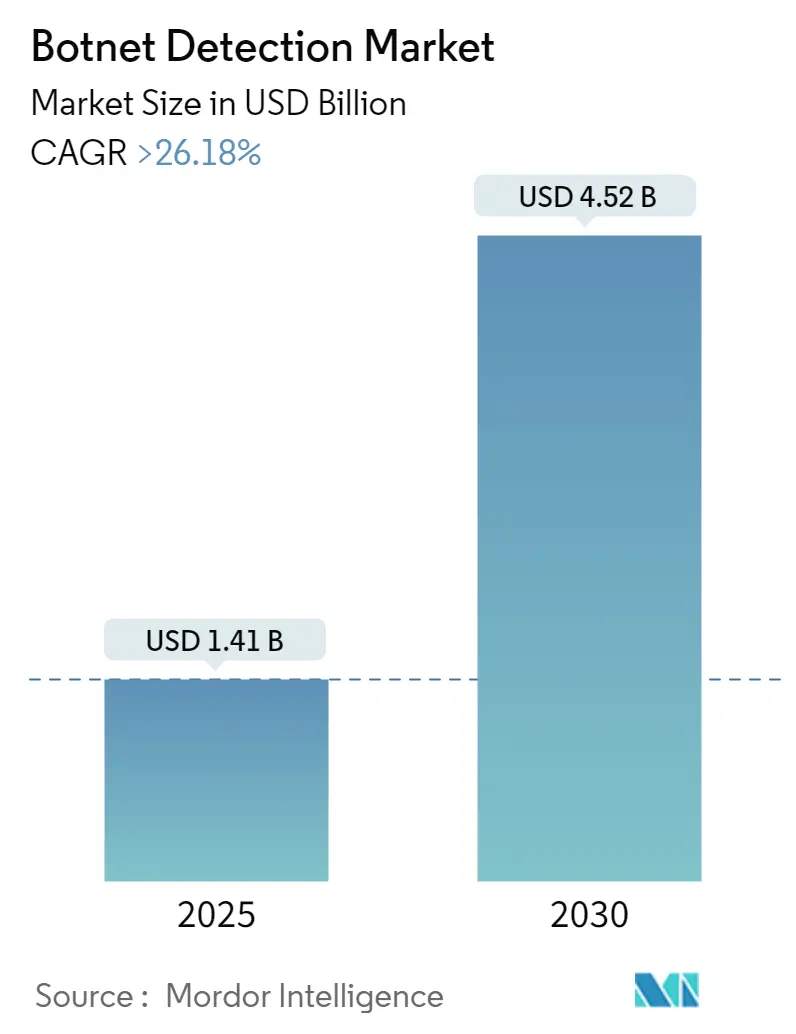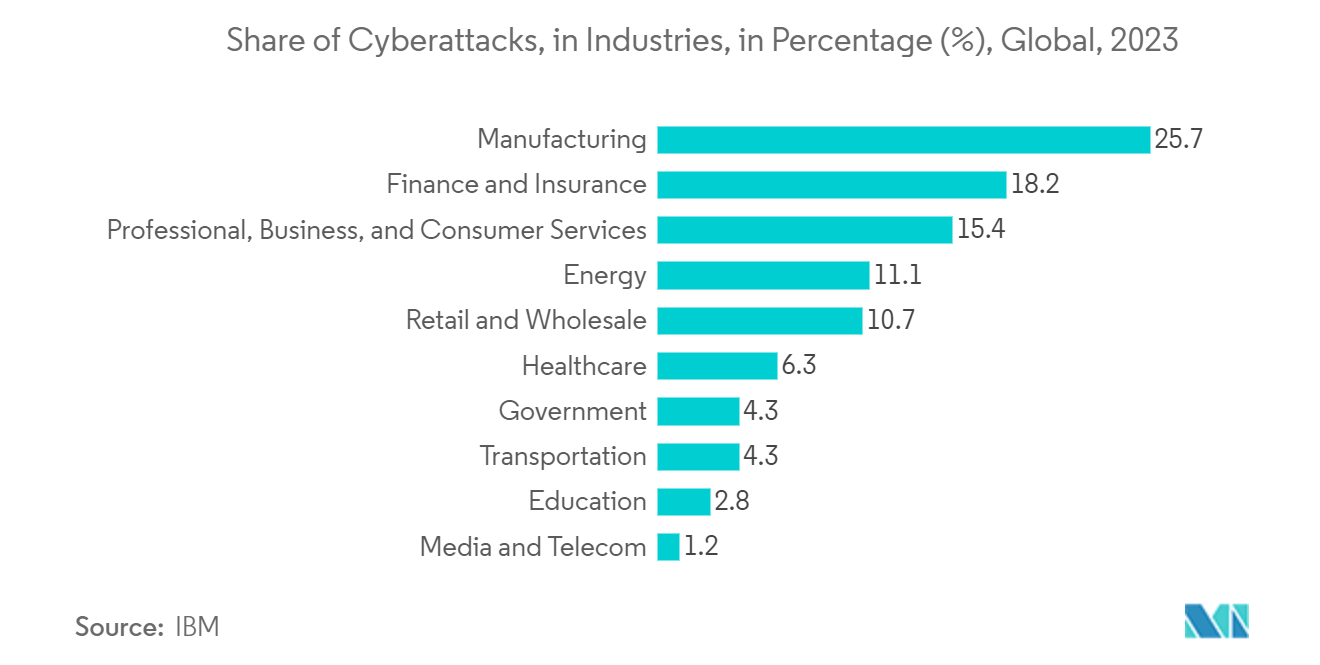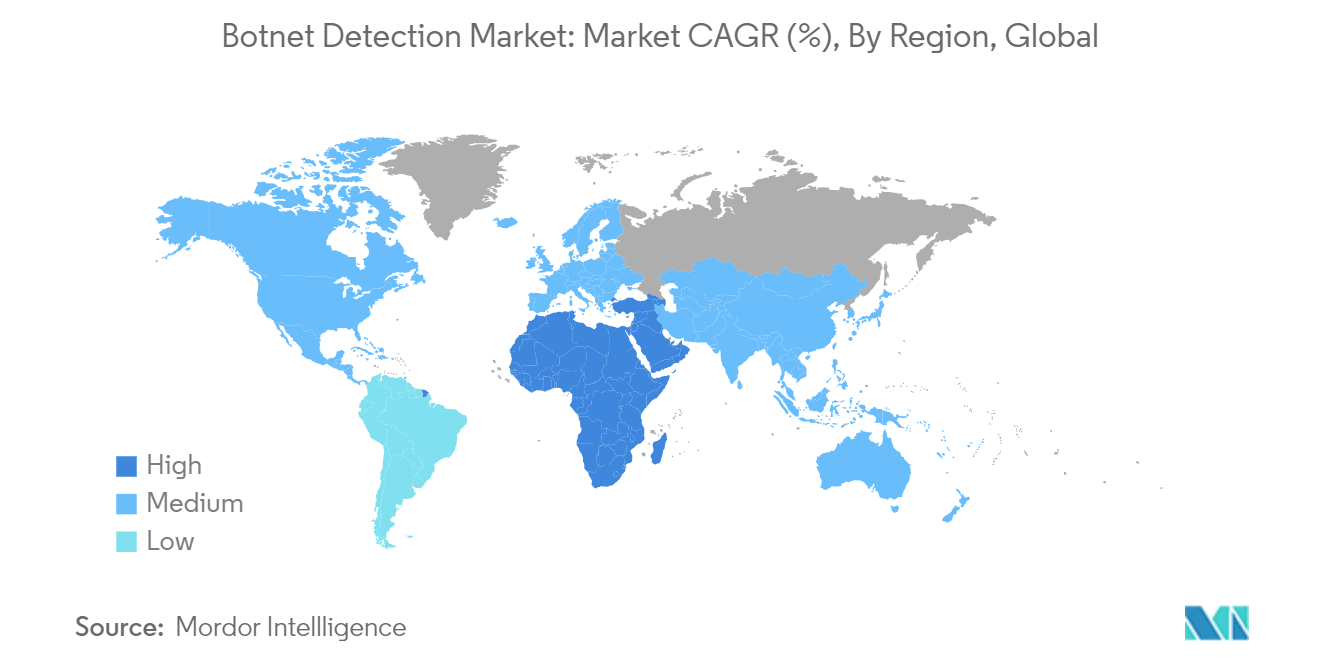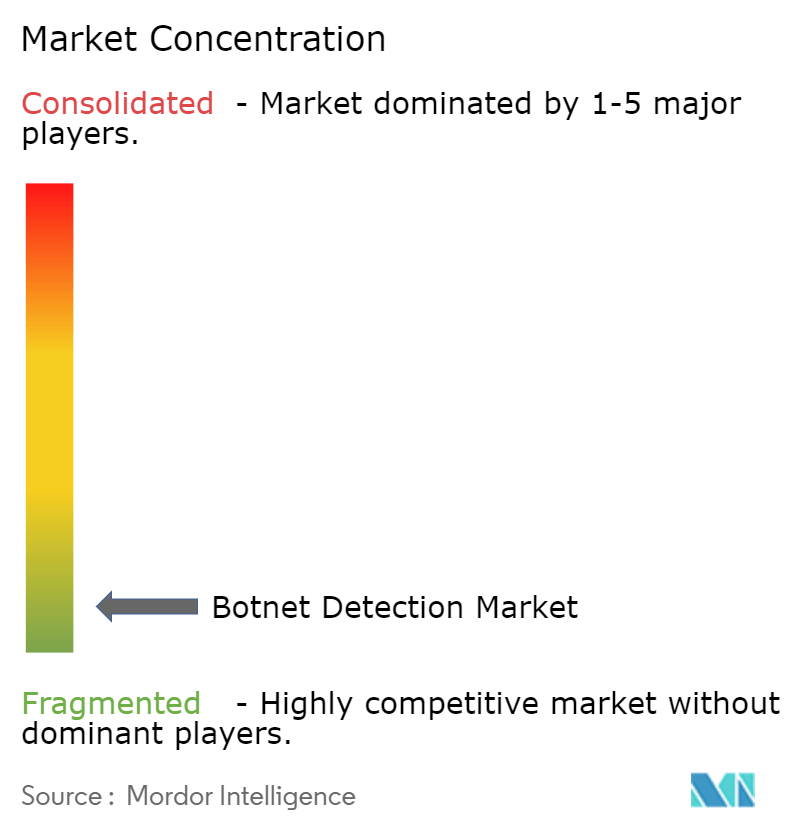Botnet Detection Market Analysis
The Botnet Detection Market size is estimated at USD 1.41 billion in 2025, and is expected to reach USD 4.52 billion by 2030, at a CAGR of greater than 26.18% during the forecast period (2025-2030).
- Cybersecurity professionals and technology firms worldwide are increasingly focusing on botnet detection. As global technology advances, the risk of its misuse also increases. Botnet attacks infringe on user privacy, allowing third parties to control individual computers. With the rising capabilities of cybercriminals, botnets have emerged as a primary threat, capable of infiltrating any internet-connected device worldwide.
- The recent Internet of Things (IoT) technology surge has introduced more endpoints for potential attackers. This evolving landscape has led to a more frequent emergence of new distributed denial of service (DDoS) bots.
- With the rise of mobile devices and cloud computing as prime attack surfaces, malicious bots have found it easier to conceal their activities. While hackers have traditionally employed these bots for financial gain, their current uses have expanded to include industrial espionage and even election manipulation. Consequently, companies are intensively cataloging and analyzing these attacks to devise effective counter-strategies.
- The integration of physical security with IP networks has broadened the attack surface for cybercriminals. These criminals have evolved, shifting from targeting individual user accounts or specific regions to dominating entire internet entities.
- Despite these advancements, companies must grapple with a significant vulnerability: a shortage of skilled cybersecurity professionals to thwart such attacks. In response, companies are not only hiring and training new cybersecurity experts to understand the evolving nature of botnets and detection software. Still, they are also pursuing mergers with major market players to bolster their service offerings and product range.
- The rapid shift to remote work during the COVID-19 pandemic, along with increased reliance on digital tools, has inadvertently created opportunities for cybercriminals. This change has resulted in a noticeable increase in cyber threats, especially botnet-driven attacks aimed at remote workers, vulnerable endpoints, and online infrastructures.
Botnet Detection Market Trends
The BFSI Segment to be the Largest End-user Industry
- BFSI organizations handling sensitive financial data are prime targets for cybercriminals aiming to steal valuable information like credit card numbers, banking credentials, and personally identifiable information (PII). Cybercriminals often deploy botnets to infiltrate these systems and exfiltrate sensitive data.
- Botnets orchestrate financial frauds, including account takeovers, identity theft, and fraudulent transactions. Thus, detecting and mitigating botnet activity is crucial for preventing financial losses and maintaining customer trust.
- BFSI organizations span multiple channels: online banking platforms, mobile apps, ATMs, and traditional branches. Botnet detection solutions must offer comprehensive protection across these channels to maintain a consistent security posture and guard against multi-vendor attacks.
- As digital technologies and online financial services increase, the BFSI segment's vulnerability to cyber threats has widened. The growth of mobile banking, digital payment platforms, and online transactions presents new challenges for botnet detection, underscoring the need for advanced solutions to counter fraud, data breaches, and other cyber risks.
- The rising frequency of cyberattacks and the potential financial and reputational fallout for BFSI organizations propel the adoption of botnet detection solutions. These solutions are proactive measures to mitigate risks, ensure regulatory compliance, and uphold customer trust and operational continuity. IBM reports that the finance and insurance sectors account for 18% of global cyberattacks among leading industries.
North America Holds Largest Market Share
- In North America, especially in the United States, many cyberattacks target diverse industries, spanning government agencies, healthcare entities, financial institutions, and beyond. Central to these assaults are botnets, underscoring the urgent need for robust botnet detection solutions among regional organizations.
- Data from the Identity Theft Resource Center highlights that in 2023, the United States recorded 3,205 data compromise incidents. That year, over 353 million individuals faced repercussions from these compromises, encompassing breaches, leakages, and exposures.
- Canada is witnessing a concerning surge in cybercrime. An August 2023 report by the Communications Security Establishment (CSE) noted 70,878 cyber fraud incidents in Canada, resulting in losses exceeding USD 390 million. With cyber threats, ransomware attacks, and data breaches becoming more frequent and sophisticated, Canadian organizations increasingly turn to botnet detection solutions for protection.
- The North American botnet detection market is shaped by a multifaceted threat landscape, stringent regulations, technological advancements, and heightened cybersecurity investments. As organizations endeavor to safeguard their data, assets, and reputations, the demand for sophisticated botnet detection solutions in the region is poised to rise.
- In fiscal year 2023, the US government allocated a budget of USD 10.89 billion for cybersecurity, marking an increase from the prior year. These federal cybersecurity funds underpin a comprehensive strategy to fortify government security and bolster the protection of critical infrastructure and vital technologies.
Botnet Detection Market Leaders
The botnet detection market is fragmented due to the presence of both global players and small and medium-sized enterprises. Key players include Imperva Inc., PerimeterX Inc. (a part of HUMAN Security Inc.), Akamai Technologies Inc., Cloudflare Inc., and DATADOME Group. These players increasingly turn to partnerships and acquisitions, bolstering their product offerings and carving out a sustainable competitive edge.
The demand for these services surges as organizations ramp up their adoption of botnet detection solutions. Market players capitalize on strategic collaborations to boost their market share and profitability. Also, companies are actively acquiring startups specializing in enterprise network equipment technologies, enhancing their product capabilities.
Botnet Detection Market Leaders
-
Imperva Inc.
-
PerimeterX Inc. (HUMAN Security, Inc.)
-
Akamai Technologies Inc.
-
Cloudflare, Inc.
-
DATADOME Group
- *Disclaimer: Major Players sorted in no particular order
Botnet Detection Market News
- March 2024: Radware, one of the leading providers of application delivery and cyber security solutions, introduced a new evolution of its Radware Bot Manager, equipped with AI-based protections. Designed to prioritize the end-user experience and meet the needs of enterprise security teams, it proactively and surgically mitigates a new generation of aggressive AI-driven, human-like bots without blocking legitimate users.
- February 2024: Akamai Technologies announced the availability of Content Protector, a product that stops scraping attacks without blocking the good traffic companies need to enhance their business. Akamai Content Protector helps identify and mitigate evasive scrapers that steal content for malicious purposes. It monitors the user's journey through the website. Botnets target specific content, resulting in significantly different behavior than legitimate traffic.
- June 2023: The Government of India provided free botnet detection and removal tools as part of its ‘Cyber Swachhta Kendra,’ also known as the Botnet Cleaning and Malware Analysis Centre. The Digital India initiative under the Ministry of Electronics and Information Technology (MeitY) focuses on creating secure cyberspace by identifying botnet infections in India and supporting people in cleaning and securing affected systems.
Botnet Detection Industry Segmentation
A botnet comprises interconnected devices on the public internet, often including compromised workstations, servers, and Internet of Things (IoT) devices, all affected by malicious software or malware. A specific attacker or group typically controls these botnets, using them mainly for criminal or malicious activities. To counter these threats and protect their assets, companies implement preventive software designed to detect such attacks.
The botnet detection market is segmented by component (solution, service), deployment type (on-premise, cloud), organization size (SMEs, large enterprises), and end-user vertical (retail, BFSI, travel and hospitality, IT and telecom, and media and entertainment), and geography (North America [United States and Canada], Europe [United Kingdom, Germany, France, and Rest of Europe], Asia-Pacific [China, India, Japan, and Rest of Asia-Pacific], Rest of the World [Latin America and Middle East and Africa]). The report offers market forecasts and size in value (USD) for all the above segments.
| By Component | Solution | ||
| Service | |||
| By Deployment Type | On-premise | ||
| Cloud | |||
| By Organization Size | SMEs | ||
| Large Enterprise | |||
| By End-user Vertical | Retail | ||
| BFSI | |||
| Travel and Hospitality | |||
| IT and Telecom | |||
| Media and Entertainment | |||
| Other End-user Verticals (Education, Healthcare, and Real Estate) | |||
| By Geography*** | North America | United States | |
| Canada | |||
| Europe | United Kingdom | ||
| Germany | |||
| France | |||
| Asia | China | ||
| India | |||
| Japan | |||
| Australia and New Zealand | |||
| Latin America | |||
| Middle East and Africa | |||
Botnet Detection Market Research Faqs
How big is the Botnet Detection Market?
The Botnet Detection Market size is expected to reach USD 1.41 billion in 2025 and grow at a CAGR of greater than 26.18% to reach USD 4.52 billion by 2030.
What is the current Botnet Detection Market size?
In 2025, the Botnet Detection Market size is expected to reach USD 1.41 billion.
Who are the key players in Botnet Detection Market?
Imperva Inc., PerimeterX Inc. (HUMAN Security, Inc.), Akamai Technologies Inc., Cloudflare, Inc. and DATADOME Group are the major companies operating in the Botnet Detection Market.
Which is the fastest growing region in Botnet Detection Market?
Asia Pacific is estimated to grow at the highest CAGR over the forecast period (2025-2030).
Which region has the biggest share in Botnet Detection Market?
In 2025, the North America accounts for the largest market share in Botnet Detection Market.
What years does this Botnet Detection Market cover, and what was the market size in 2024?
In 2024, the Botnet Detection Market size was estimated at USD 1.04 billion. The report covers the Botnet Detection Market historical market size for years: 2019, 2020, 2021, 2022, 2023 and 2024. The report also forecasts the Botnet Detection Market size for years: 2025, 2026, 2027, 2028, 2029 and 2030.
Our Best Selling Reports
Botnet Detection Industry Report
Statistics for the 2025 Botnet Detection market share, size and revenue growth rate, created by Mordor Intelligence™ Industry Reports. Botnet Detection analysis includes a market forecast outlook for 2025 to 2030 and historical overview. Get a sample of this industry analysis as a free report PDF download.

